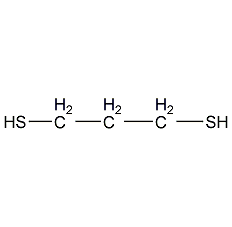
Structural formula
| Business number | 02ZU |
|---|---|
| Molecular formula | C3H8S2 |
| Molecular weight | 108.23 |
| label |
1,3-Dimercaptopropane, 1,3-propane disulfide paraffin oil, 1,3-propyldithiol, HS(CH2)3SH, 1,3-Dimercaptopropane, Propane-1,3-dithiol, aliphatic compounds |
Numbering system
CAS number:109-80-8
MDL number:MFCD00004904
EINECS number:203-706-9
RTECS number:TZ2585500
BRN number:1071197
PubChem number:24898586
Physical property data
1. Characteristics: Colorless Liquid with a foul odor.
2. Density(g/mL,20℃):1.078
3. Relative vapor density (g/mL,air =1): >1
4. Melting point (ºC): -79
5. Boiling point (ºC,normal pressure): 169
6. Boiling point (ºC, kPa): Not determined
7. Refractive index:1.539 ; mso-bidi-font-family: Arial; mso-font-kerning: 0pt”>
8. Flashpoint (ºC): 63
9. Specific optical rotation (º): Undetermined
10. Autoignition point or ignition temperature (ºC): Undetermined
11. Vapor pressure (mmHg,37.7ºC): 5
12. Saturated vapor pressure (kPa, ºC): Undetermined
13. Heat of combustion (KJ/mol): Undetermined
14. Critical temperature (ºC): Undetermined
15. Critical pressure (KPa): Undetermined
16. Oil and water (octanol/Water) logarithmic value of the partition coefficient: 2.28
17. Explosion limit (%,V/V): Undetermined
18. Lower explosion limit (%,V/V): Undetermined
19. Solubility:Not yet OK
Toxicological data
1, acute toxicity: mice oral LDL0: 1070mg/kg; Feline veinLD50:28mg/kg
Ecological data
This substance is harmful to the environment, and special attention should be paid to the pollution of water bodies.
Molecular structure data
5. Molecular property data:
1. Molar refractive index:31.74
2. Molar volume (m3/mol):106.1
3. Isotonic specific volume (90.2K): 255.2
4. Surface tension (dyne/cm): 33.4
5. Polarizability(10-24 cm3):11.58
Compute chemical data
1. Reference value for hydrophobic parameter calculation (XlogP): 1.2
2. Number of hydrogen bond donors: 2
3. Number of hydrogen bond acceptors: 2
4. Number of rotatable chemical bonds: 2
5. Number of tautomers: none
6. Topological molecule polar surface area 2
7. Number of heavy atoms: 5
8. Surface charge: 0
9. Complexity: 12.4
10. Number of isotope atoms: 0
11. Determine the number of atomic stereocenters: 0
12. Uncertain number of atomic stereocenters: 0
13. Determine the number of chemical bond stereocenters: 0
14. Number of uncertain chemical bond stereocenters: 0
15. Number of covalent bond units: 1
Properties and stability
Avoid contact with oxides. After decomposition, carbon monoxide, carbon dioxide, sulfur oxide, and hydrogen sulfide can be produced.
Storage method
Stored in a cool, ventilated warehouse. Keep away from fire and heat sources. The storage temperature should not exceed 30℃. Keep container tightly sealed. They should be stored separately from oxidants, alkalis, and alkali metals, and avoid mixed storage. Use explosion-proof lighting and ventilation facilities. It is prohibited to use mechanical equipment and tools that are prone to sparks. The storage area should be equipped with emergency release equipment and suitable containment materials.
Synthesis method
None yet
Purpose
Used as daily fragrance.
auto; mso-list: l0 level2 lfo1; tab-stops: list 36.0pt” align=left>3. Isotonic specific volume (90.2K): 255.2
4. Surface tension (dyne/cm): 33.4
5. Polarizability(10-24 cm3):11.58
Compute chemical data
1. Reference value for hydrophobic parameter calculation (XlogP): 1.2
2. Number of hydrogen bond donors: 2
3. Number of hydrogen bond acceptors: 2
4. Number of rotatable chemical bonds: 2
5. Number of tautomers: none
6. Topological molecule polar surface area 2
7. Number of heavy atoms: 5
8. Surface charge: 0
9. Complexity: 12.4
10. Number of isotope atoms: 0
11. Determine the number of atomic stereocenters: 0
12. Uncertain number of atomic stereocenters: 0
13. Determine the number of chemical bond stereocenters: 0
14. Number of uncertain chemical bond stereocenters: 0
15. Number of covalent bond units: 1
Properties and stability
Avoid contact with oxides. After decomposition, carbon monoxide, carbon dioxide, sulfur oxide, and hydrogen sulfide can be produced.
Storage method
Stored in a cool, ventilated warehouse. Keep away from fire and heat sources. The storage temperature should not exceed 30℃. Keep container tightly sealed. They should be stored separately from oxidants, alkalis, and alkali metals, and avoid mixed storage. Use explosion-proof lighting and ventilation facilities. It is prohibited to use mechanical equipment and tools that are prone to sparks. The storage area should be equipped with emergency release equipment and suitable containment materials.
Synthesis method
None yet
Purpose
Used as daily fragrance.
mso-bidi-font-family: Tahoma; mso-font-kerning: 1.0pt; mso-ansi-language: EN-US; mso-fareast-language: ZH-CN; mso-bidi-language: AR-SA”> Used as daily fragrance.

 微信扫一扫打赏
微信扫一扫打赏

